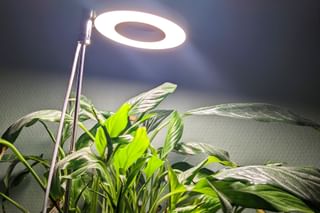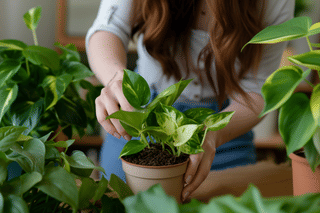5 plants that brighten your home's dark, empty corners
Discover the top five houseplants perfect for low-light conditions in this comprehensive guide. Learn about the Peace Lily, ZZ Plant, Pothos, Dracaena, and more to find the ideal low-maintenance, air-purifying companion for those darker corners of your home.
If you, like me, live in a place that doesn't get a lot of sunlight for a large part of the year, or you don't have a lot of windows to let in sunlight, some of your plants will struggle in your house. All plants need some level of sunlight exposure, but some need more than others.
If you have some of these empty dark corners that deserve some love, why not consider a few plants that can survive in low-light conditions? What's a better way to brighten a space, even a dark one, than filling it with a plant (or 5)?
In this post, I'm highlighting 5 plants that I've had success with in darker corners and I think you'll like all of these.
These are the plants:
Let's get started with one of my very first houseplants: Sansevieria!
1. Snake Plant (Sansevieria)
The Snake Plant, or Mother-in-Law's Tongue, is one of the easiest plants to thrive in low-light conditions. These plants are completely fine if you forget about them for weeks. They need very little attention, and very little water, and best of all, they stay the same size in these dark corners of your house.
These tough plants stay the same size because they'll need sunlight to grow. So if you don't give them any, it'll just stay the same size. This also means you won't have to water it for weeks. The plant is frozen in time.
So you won't have to take care of them a lot, that's great! But there is one more bonus point if you get this plant! It purifies the air. So it won't just look great, it also helps you breathe a little more easily.
If you're still not convinced this plant will do well in your dark corners, perhaps this will help: I've had the same sansevieria on my desk, where I'm writing this post, in a dark room without any windows, for 3 years. It's looking great, stayed the same size, and doesn't take any effort to take care of. Perfect for this space.
If you only want to pick up one of the plants in this post, pick up a Sansevieria! But, there are a few other great plants too! Let's look at a Peace Lily.
2. Peace Lily (Spathiphyllum)
The Peace Lily is boring?! That's what I thought when I first got mine. It doesn't have any patterns and when you keep it in a dark spot, it also doesn't grow its recognizable white flowers. Those flowers need sunlight to grow. It's essentially a collection of green, elongated leaves. But is the plant really that boring? Absolutely not!
5 years ago, when I first got this plant, I got it because it was great for low light. My office space is quite dark, so I thought this plant would survive this dark space. And surviving it did! Now, after 5 years, this plant is still happy in this dark spot and is still actively growing.
One of the great parts of the Peace Lily is that it likes moisture. This makes the plant great for those of us who like to regularly give our plants a little bit of love. The Sansevierias are great, but not everyone can just ignore a plant for weeks at a time. The Peace Lily is a great plant if you want to water it once per week and just have a nice, dark green plant in those gloomy living spaces.
Like the Sansevieria, this plant also purifies the air to help you breathe. Perhaps a little spoiler alert, but every plant in this post purifies the air.
So if you're someone who likes to actively take care of your plants, you have a dark and empty corner, I can highly, highly recommend the Peace Lily. It's very tough and its leaves add a nice jungle texture to your house.
3. ZZ Plant (Zamioculcas zamiifolia)
Looking for a low-maintenance, tough, easy-to-propagate houseplant that's not a Sansevieria? You might be looking for a ZZ plant! I've always liked the ZZ plant because it looks like a plant with normal leaves, but these leaves are thick and waxy, much like a succulent.
I always saw the ZZ plant as a large succulent, and if you look at how to take care of this plant, you'd think it is a succulent as well. The ZZ plant needs very little water because it has thick stems that hold a lot of moisture and can keep the plant hydrated for a few weeks.
Unlike the Sansevieria, the ZZ plant will still grow when you keep it in a darker place. This is one of the times I recommend you (temporarily) move your plant to a brighter spot. When the new stem grows and you keep it in a dark spot, the stem will become very leggy and its leaves will stay light almost neon green. I move my ZZ plant to a bright spot when new stems are growing and once they're done, they're going back in their dark spots.
Besides moving this plant to a brighter spot while it's growing, it's a low-maintenance plant like Sansevieria, so it's great for those of you who tend to forget about your plants. This plant will love it!
If you're feeling extra adventurous, I suggest trying to find a ZZ raven: a completely Black ZZ plant. This plant looks unlike any other plant you've ever seen and will make that dark and empty space unique!
4. Pothos (Epipremnum aureum)
Pothos is a plant that will make your house seem like a jungle. The vines can grow long without much effort, so you can use this plant to fill in an abandoned corner of your house.
The best part about a Pothos is that it grows very quickly and it likes to get water quite regularly. This makes the Pothos a perfect plant for those of us who want to give our plants a little love, like with the Peace Lily!
Most plant owners also underestimate the satisfaction that comes with taking care of a fast-growing plant. Because it grows so fast, you feel like the plant is rewarding your great care routine immediately.
Pothos is a plant that likes its soil to dry out in between waterings, as it stores a lot of moisture in its long vines. However, don't keep this plant in dry soil for too long, as that will dry out the plant. It's not like a Sansevieria and ZZ plant in the sense that it likes to be ignored. The Pothos does need regular watering: once every 10 days in the winter and once per week in the summer.
One more thing about the Pothos that I think is important for you to know: pruning is very important. When you keep your Pothos in a dark spot, its vines will be a little leggy and it won't be as full and bushy as a Pothos that gets bright, indirect sunlight. To help with this, you can regularly (once at the beginning of spring and once at the beginning of summer is best) prune long vines and propagate them. This helps to keep the plant bushy and also promotes new growth.
5. Dracaena

Last but not least is my first "large" plant, the Dracaena Marginata. If none of the other plants fit your ideal plant care routine, this plant is a great choice! Let me explain.
The Dracaena is a great plant for darker corners and is very good at purifying the air. It's a plant that doesn't like too much water, but it also doesn't like to be dry for weeks at a time. This means it's great for those of you who like to take care of your plants regularly, but don't have a lot of time to do this weekly. That's completely fine with a Dracaena.
On average, I've been watering my Dracaena once every 14 days for the past 5 years and it seems to respond well to this. When I first got this plant, I forgot to water it for a little longer and when it gets too dry, its leaves will become brown and crispy before falling off. But this plant is also very sensitive to overwatering, so in my experience, watering it once every 2 weeks is the right balance.
But its easy care routine isn't the only reason why I often recommend this plant for low-light spots. It also just looks unique. Dracaena is one of the strangest (in a good way) looking houseplants that I have. It's a single stem, with 3 branches at the top, and those playful upright leaves. It's just very different from any of my tropical houseplants that take up space in the brighter spots of my house.
Dracaena, because they can be larger plants, will be great at filling in those darker corners and they'll be happy there for years.
Conclusion
And there you go, my five favorite beautiful plants ready to light up even the gloomiest spots in your house. Go ahead and introduce these green wonders into your space, and see how they effortlessly turn bland spots into lively areas. Remember, every plant comes with its own set of care instructions, so make sure to look up their needs before you decide to take one home.
Thank you for reading this post! I hope it helps you to keep your plants healthy and beautiful! If you're looking for more guides on specific plants, you can always request a plant guide to get a guide for the plant you have trouble with.
Test your plant care knowledge
Quiz completed!
Want to learn more? Sign up for my newsletter to receive free tips in your inbox!
Sign up now!












